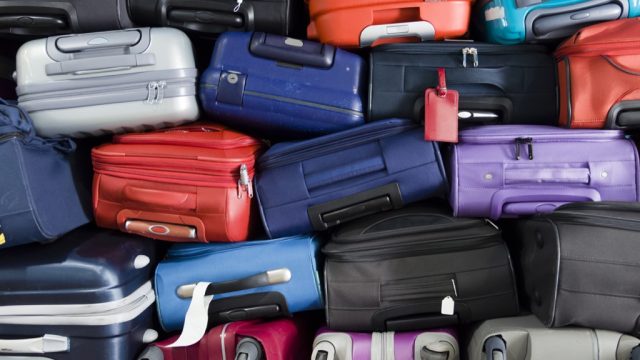This Is What Happens to All Your Missing Luggage

It’s every traveler’s worst nightmare to wait by the baggage claim and watch suitcase after suitcase circle around the conveyor belt with yours nowhere to be seen. Then, after hours complaining to customer service about your missing luggage, you’re stranded with no clothes or personal possessions. Talk about a terrible way to begin or end a vacation.
Luckily, the odds are pretty slim that your checked bag will be misplaced over the course of your travels. In 2018, 24.8 million bags were “mishandled”—meaning: lost, damaged, delayed, or pilfered—according to a 2019 report by SITA, an aviation technology company that monitors bag tracking data for airlines around the world. Sure, that’s a massive number of missing suitcases, but it pales in comparison to the total number of air passengers who flew in the same year: 4.36 billion people. Assuming each passenger brings at least one bag (including carry-ons) with them on their trip, that means only 0.6 percent of all bags flown in 2018 were mishandled.
The truth? It’s rare to lose your luggage for good. In 2018, only 5 percent of all missing luggage, or about 1.24 million bags total were not eventually returned to their owners. Airlines are responsible for getting your bag to your final destination, though, so they’ll usually just stick the bag on the next flight.
Where unclaimed suitcases are sent
If you’re among the unfortunate few whose suitcase is well and truly lost—whether it’s stolen or it simply vanished—it’s a good bet they’ll end up at one place: the Unclaimed Baggage Center, a 40,000-square-foot warehouse in Alabama where strangers sift through recycled stuff like a thrift store. Airlines have 90 days to return missing luggage; after that, they belong to the airline, which can sell the orphaned suitcases through its exclusive contract with the UBC. (Note: The company also buys unclaimed goods from train stations and car rentals.)
Known as the Lost Luggage Capital of the World, the UBC has its sorting process down to a science. First, all items are divided into three groups: sell in the store, trash, or donate to charities like The Salvation Army. If clothing is labeled to sell, it gets washed at the on-site commercial dry cleaner, while electronics are wiped and reset in accordance to Department of Defense protocol, so there’s no security risk.
An estimated 7,000 new items arrive every day, from the missing luggage itself to the clothes, jewelry, music instruments, ski gear, and other miscellaneous possessions that were once packed inside. With this much inventory, it’s no surprise that the UBC is a treasure trove of weird and wondrous items—so much so that it even has a museum dedicated to its most eclectic pieces, such as a full suit of armor, a 40.95-carat natural emerald, and an ancient Egyptian burial mask.
What to do if your bags are misplaced
If the worst should happen and your duffel goes completely MIA—and you don’t want a lucky customer in Alabama to buy your wares—here’s what you should do.
First, file a missing bag report with your airline ASAP. Most airlines set a deadline for you to file a claim to receive compensation, usually ranging from four to 24 hours after your arrival. At major airports, there will be a dedicated desk for missing baggage, where you can file your claim in person, otherwise you might need to call your airline. Keep in mind that airlines (and travel insurance policies) usually offer some form of compensation for delayed or lost luggage, so be sure to read the fine print and ask for the full amount applicable to your case.
But be aware that even after submitting a claim, they may only give you a measly $50—which is a drop in the bucket if you’ve lost expensive accessories or sentimental items. The bright side? You have some rights as a passenger. According to the Department of Transportation, you can be paid up to $3,500 in liability if your checked bags were lost or damaged during a domestic flight and up to $1,545 on an international trip. Cha-ching!
How to avoid losing your luggage
New developments in baggage handling technology are helping airlines and passengers keep a closer eye on their checked bags throughout their journeys. For instance, in 2016, Delta spent $50 million to install RFID trackers in its bag tags and loading systems, meaning a passenger can see where their bag is in the process at any given time using the airline’s app.
There are a few preemptive steps you can take, too. Primarily, photograph your suitcase and write down its brand and model, so the airline can identify it. Then when you check your bag, the airline agent will stick your receipt with a barcode and a tracking number on the back of your boarding pass—be sure to keep this in a safe place!
You can also invest in a smart suitcase with built-in locators. One such favorite is the sleek luggage company AWAY, which features Tile tracking tags that connect to your phone via Bluetooth. This allows you to check where your bag is in real time. If you’re already attached to your suitcase and want a more affordable option, buy an individual tracker like LugLoc or Trakdot, both of which use GSM or GPS technology. And for more great insider airport tips, check out the 20 Genius Ways to Make Flying Less Miserable.